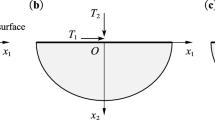Abstract
The form of the classical stress–strain relations of linear elasticity are considered here within the context of nonlinear elasticity. For both Cauchy and symmetric Piola-Kirchhoff stresses, conditions are obtained for the associated strain fields so that they are independent of the material constants and compatible with existence of a strain–energy function. These conditions can be integrated in both cases to obtain the most general strain field that satisfies these conditions and the corresponding strain–energy function is obtained. In both cases, a natural choice of form of solution is suggested by the special case of the compatibility conditions being satisfied identically. It will be shown that some strain–energy functions previously introduced in the literature are special cases of the results obtained here. Some recent linear stress–strain relations, proposed in the context of Cauchy elasticity, are examined to see if they are compatible with hyperelasticity.
Similar content being viewed by others
References
Batra R.C.: Linear constitutive relations in isotropic finite elasticity. J. Elasticity 51, 243–245 (1998).
Batra R.C.: Comparison of results from four linear constitutive relations in isotropic finite elasticity. Int. J. Non-Linear Mech. 36, 421–432 (2001).
Chiskis A., Parnes R.: Linear stress–strain relations in nonlinear elasticity. Acta Mech. 146, 109–113 (2001).
Volokh K.Y.: Comments and authors’ reply on “Linear stress–strain relations in nonlinear elasticity” by A. Chiskis and R. Parnes. Acta Mech. 171, 241–245 (2004).
Anand L.: On H. Hencky’s approximate strain–energy function for moderate deformations. ASME J. Appl. Mech. 46, 78–82 (1979).
Nader J.J.: Linear response in finite elasticity. J. Elasticity 73, 165–172 (2003).
Bartle R.G.: The Elements of Real Analysis. Wiley, New York (1976).
Hencky H.: Über die form des Elastizitatsgesetzes bei ideal elastischen Stoffen. Z. Techn. Phys. 9, 215–220 (1928).
Bruhns O.T., Xiao H., Meyers A.: Hencky’s elasticity model with the logarithmic strain measure: a study on Poynting effect and stress response in torsion of tubes and rods. Arch. Mech. 52, 489–509 (2000).
Bruhns O.T., Xiao H., Meyers A.: Constitutive inequalities for an isotropic elastic strain–energy function based on Hencky’s logarithmic strain tensor. Proc. R. Soc. Lond. A 457, 2207–2226 (2001).
Ogden R.W.: Non-linear Elastic Deformations. Dover Publications, New York (1997).
Author information
Authors and Affiliations
Corresponding author
Rights and permissions
About this article
Cite this article
Murphy, J.G. Linear Isotropic Relations in Finite Hyperelasticity: Some General Results. J Elasticity 86, 139–154 (2007). https://doi.org/10.1007/s10659-006-9088-7
Received:
Accepted:
Published:
Issue Date:
DOI: https://doi.org/10.1007/s10659-006-9088-7




